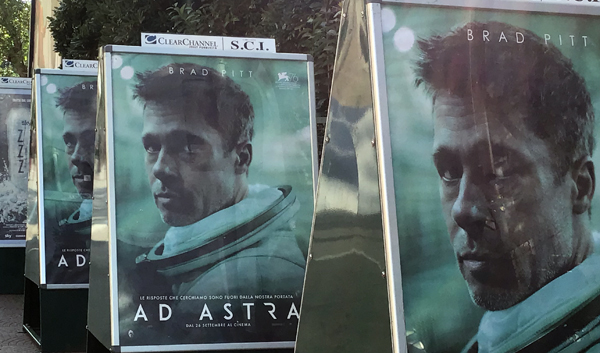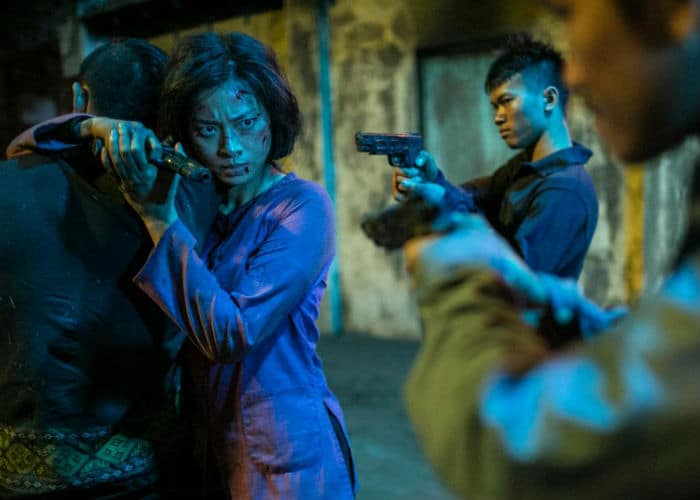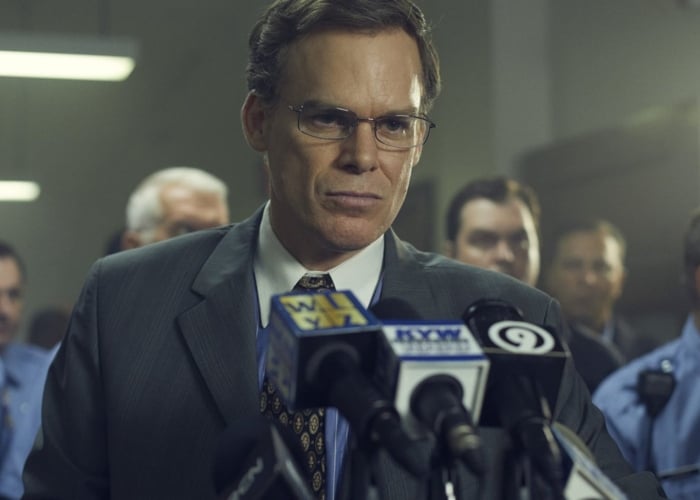
A year after the walls of the Sala Darsena thrummed to Damien Chazelle’s Ryan Gosling-led voyage to the moon, First Man, Venice braced for another space journey. For a festival that’s traditionally allocated the coveted opening slot to big studio productions and grand epics, it felt somewhat surprising to see the 76th official lineup kick off with Hirokazu Kore-eda’s The Truth and not what was trumpeted as the year’s biggest epic among its twenty-one Golden Lion contenders, Ad Astra. James Gray’s latest—and largest commercial undertaking to date—found a slot in the second festival day. A Brad Pitt vehicle, it was the sort of blockbuster-to-be that would leave the streets around the Sala Grande’s red carpet swamped with fans fishing for autographs and pictures (it didn’t help, as far as freedom of movement along the island went, that the other title in competition scheduled the same day was Noah Baumbach’s Marriage Story, another star-studded project featuring Scarlett Johansson, Adam Driver, and Laura Dern, with the trio expected to grace the carpet before Pitt’s film).
Quite a departure from Gray’s previous earthling offerings—if you can attach a leitmotif to a protean canon that’s spanned crime dramas (his 1994 Little Odessa and 2007 We Own the Night), romances (Two Lovers, 2008), and period pieces (The Immigrant, 2013; and The Lost City of Z, 2016)—Ad Astra feels at once modern and traditional. A sci-fi epic set in a undefinably near future (“a time of both hope and conflict,” as the title cards have it, where the Earth’s fight for natural resources has spilled in outer space), it harkens back to myths as old as storytelling itself. The word of mouth that trickled across the Lido ahead of its world premiere touted Gray’s sci-fi epic as a curious cross-breed between Kubrick’s 2001: A Space Odyssey and Coppola’s Apocalypse Now. The analogy hardly holds, to the point that it almost feels apple-and-oranges unkind, but while Ad Astra doesn’t bestow that ageless, mythic wonder of either masterpiece, the references do speak to the core of Gray’s new drama, at least as far themes go.
Brad Pitt is Major Roy McBride, an astronaut with an illustrious career helming the construction of the world’s largest antenna, an iron giant towering atop the US and piercing through the atmosphere to scout for alien intelligence. He’s the son of Clifford McBride (Tommy Lee Jones), a legendary astronaut who devoted his whole life to the same pursuit. Decades prior, McBride senior left the Earth to embark on the Lima Project, a mission designed to locate extraterrestrial life in outer space. Sixteen years after its launch, the ship went missing, and Clifford presumed dead. But when a series of power surges strikes the Earth, the result of cosmic rays which US intelligence believe to emanate from the Lima Project’s last known headquarters around Neptune, Roy is asked to lead a space mission to communicate with the long-lost spaceship. Classified reports indicate the starship may still be out there, and Clifford the man responsible for the devastation waged across the solar system.
An interplanetary quest that unfolds as an outward journey as much as an inner, homeward one, Ad Astra gravitates around a defunct father-son relationship, as Roy trails after a Colonel Kurtz-like parent with a past lacquered with countless achievements, and whose hubris has driven to raging madness. Cinematographer Hoyte Van Hoytema follows up on his work in Interstellar, painting outer space as a milieu both terrifying and stashed with spellbinding beauty, but it’s from the closed-off spaces production designer Kevin Thompson locks Pitt all along the trip that Ad Astra feels most perturbing. Together with a stoic work ethic, Roy has inherited from Clifford a preternatural ability to neutralize his emotions (“I’ve been told to compartmentalized,” he muses), and his psychological duress—the reason why he’s been chosen to helm the Neptune-bound emergency mission, despite the family ties—is a running theme. Confinement cells billed as "relaxation rooms" house the astronaut during the trip, the ostensibly tranquil and peaceful images projected on the walls shimmering menacingly as the journey unfolds.
Penned by Gray, the script interpolates space flights with moments where Roy debriefs on the emotional costs the mission carries, psychological evaluation tests the astronaut submits himself periodically to a computer, and spiral into omnipresent voiceovers—echoing the sort of inner musings Martin Sheen had engaged in on his way to meet Brando in Vietnam. But where
Apocalypse Now used the voiceovers with a certain parsimoniousness, here they take on a far more pervasive and suffocating flair. An inner journey that grows parallel and just as tortuous as the one in space, Gray’s choice to rely on voiceovers to describe Roy’s emotional struggle detracts from pathos and rhythm. They span from Roy’s ruminations on the mission’s real goals to his strained father-son relationship, far more clunky and verbose than they are lyrical and poignant. Not only do they hardly carry the narrative forward, they strike as superfluous detritus, unnecessary noise, largely because Pitt’s face—which Van Hoytema captures in recurrent close-ups—conveys far more than they ever could. Reviewing Tarantino’s latest from Cannes, Stephanie Zacharek had observed in her
Once Upon a Time… in Hollywood review how Pitt’s looks seems to have acquired, at 55, “a weathered perfection.” Here too, he saunters through space like a time-consumed hero, his glacial stare etched by years of solitary work crumbling as the distance from his father grows smaller, and the emotional void bursts more painfully.
But the stiffness and clunkiness does not emanate from the voiceovers alone: it extends all across the script, a feeling that manifests itself most vividly during the unnervingly anticlimactic encounter between Pitt and Jones. There’s only so much pathos father and son can stir from dialogues that make them sound as if they were spitting lines at each other, a long way away from the emotional wreckage Ad Astra had promised to conjure, but doesn’t quite deliver. Far into the voyage, as Roy admires the stunning photographs of faraway planets his father had observed and shot through years of research, Pitt comments on their beauty with a sad tone: “beneath their sublime surfaces, there was nothing.” A gorgeously shot, but emotionally stunted epic, I fear the same may ring just as true to Gray’s own project.

If Ad Astra was a son bellowing his father’s name into outer space, Noah Baumbach’s Marriage Story couches the drama from the opposite vantage point. A follow up to his 2017 The Meyerowitz Stories (New and Selected), which had bowed in Cannes before the whole Netflix debacle made the streaming giant to look for other pastures, this is another study of broken families, except the focus here is firmly rooted on a single couple, told not from the perspective of a son grappling with his parents’ divorce (as it had been in Baumbach's The Squid and the Whale), but from the couple’s own.
Adam Driver is Charlie; Scarlett Johansson is Nicole. They are a married duo living in New York, Baumbach’s home turf, but hail from different states: Nicole a Los Angeles transplant, Charlie an Indiana native. She’s left California and a TV career still in its embryonic stages to follow him to the city, where he directs a theatre company, and she serves as lead in his productions—conceptual pieces people alternatively describe as “edgy,” “avant-garde,” and “genius.” Robbie Ryan’s handheld camerawork introduces them with a preamble of quiet domestic pleasures—or rather, each introduce the other, as Nicole’s voiceover lists Charlie’s idiosyncrasies, and vice versa. But these are no valentines, and the soothing feeling they elicit, much like the free-floating camerawork, soon come to a screeching halt. Charlie and Nicole are separating: the lists, imbued with longing and affection, are letters a counsellor has asked them to write, but which neither has enough courage to read to the other. They have a child together, whose custody will soon be up for dispute. Nicole is set to move back to L.A., Charlie fights for the three to remain in New York. This is the story of a couple disintegrating, where the divorce looms as some inescapable outcome all throughout, a journey that’s at once devastating, hilarious, empathetic, and heart-wrenchingly vivid.
In a tale whose ending is essentially telegraphed from the first few minutes, Marriage Story thrums with the energy of some pulsating organ. It’s a deeply personal journey that ultimately transcends the couple at its center, precisely because it understands both halves down to their innermost quirks. Baumbach (here again on double writer-director duty) has possibly never penned anything this stellar, a script where screwball comedy chuckles teem with tragedy. But it is the perfect symbiosis between writing, directing, and Jennifer Lame’s work in the editing room that allows the plot to shift tones in the time that lasts an hairsbreadth, with scenes that carom off excruciatingly funny segments to others of lacerating sadness. In one, Nicole’s attempts to hand Charlie the divorce papers stall in a series of hilarious mishaps, a towering crescendo of laughs that plummets in a shattering silence; in another, an attempt to find a truce and escape the courtroom agonies draws husband and wife into a ferocious altercation, only to default to a tear-jerking embrace. Marriage Story could have all easily slipped into a pathetic, melodramatic terrain; that it never quite does is Baumbach’s merit as much as his outstanding leads—Driver and Johansson concurrently injecting unhinged force and vulnerability into their parts.
Clocking at 136-minutes, the pace may not be not even through, all the more so when Baumbach zeroes in on the perilous judicial journey the two embark on, and the plot ventures in a court procedural terrain. But if so much emphasis is devoted to the backroom fights and negotiations between lawyers (with a scene-stealer Laura Dern as Nicole’s), it’s because Marriage Story is a movie about a couple’s divorce as much as a study of how divorce operates: a critique of its apparatus, its choreographies, its judicial etiquette, as well as the financial and emotional costs it demands from those who go through it. Told as it may be for the most part from Charlie’s perspective, it does not side with him. Much of what makes Marriage Story such humane a tale is Baumbach’s decision to withhold judgment over the couple’s two halves, and to pour as much affection and empathy into each. This is a generous story: for all the resentments and insults they fire at each other, neither Charlie nor Nicole ever give in to their lawyers’ advice that their past life together must be re-written to ensure a win in court. “It’s not as simple as not being in love anymore,” Johansson describes her conundrum to Dern in an early meeting, but it’s the kind of truth that could only truly be appreciated and understood by her and Charlie alone.
The space travelers in Ad Astra searched for new consciousness in space only to realize life on Earth is all we’ve got. In Marriage Story, Baumbach lands on a similar epiphany. All along Charlie’s legal battle, people try to cajole the man into abandoning crammed New York to settle in spacious L.A. But the interiors people in Marriage Story inhabit (scarcely furbished apartments, sleek high-rise offices, plush homes) are just vast as the emotional void their tenants harbor. It’s only the festival’s second day, but Venice may have found an early charmer already.







































